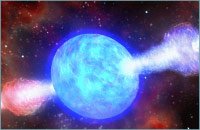Fermi brings high energy sky map
Sunday, March 15, 2009
The Fermi Gamma-ray Space Telescope science has provided an unprecedented look at the high energy universe. Fermi scans every three hours the entire sky at gamma wavelengths, which allows astronomers to change high-energy sources are easy to detect. Now you 87 days to observations combined into a single sky map. This map shows how the universe would look like, if our eyes could absorb radiation that 150 million times more energetic than visible light.
The sky map shows many sources of gamma radiation, both within and outside our galaxy. These include super-massive black holes, pulsars, interacting binary stars and even entire clusters. The scientists have published an article in which the 205 brightest sources in the catalog of Fermi described. Fermi's team has it a "top ten" complex, which consists of five sources in the Milky Way and five sources outside the Milky Way.
View a high resolution version with labels.
http://www.nasa.gov/images/content/317870main_Fermi_3_month_labeled_new.jpg
Another image:
Sunday, March 15, 2009
The Fermi Gamma-ray Space Telescope science has provided an unprecedented look at the high energy universe. Fermi scans every three hours the entire sky at gamma wavelengths, which allows astronomers to change high-energy sources are easy to detect. Now you 87 days to observations combined into a single sky map. This map shows how the universe would look like, if our eyes could absorb radiation that 150 million times more energetic than visible light.
The sky map shows many sources of gamma radiation, both within and outside our galaxy. These include super-massive black holes, pulsars, interacting binary stars and even entire clusters. The scientists have published an article in which the 205 brightest sources in the catalog of Fermi described. Fermi's team has it a "top ten" complex, which consists of five sources in the Milky Way and five sources outside the Milky Way.
View a high resolution version with labels.
http://www.nasa.gov/images/content/317870main_Fermi_3_month_labeled_new.jpg
Another image:
Attachments
Last edited:


